In June, I was honored and humbled to present on two topics at the International Play Association Triennial Conference in Glasgow, Scotland. With only 550 attendees, many of whom were presenters as well, the conference was jam-packed with data, experience, and fun from all over the world.
What were the takeaways?
- Finland, the traditional poster child for how schools should use play and recess to improve test scores, behavior, and mental health, is getting a run for its money. Scotland is putting play front and center with heavy government backing both financially and legislatively. Riding right behind is Australia, who is using creative concepts to encourage more play in and out of school specifically targeting underserved communities with great success. Where is the U.S.? Far, far behind. Sadly when talking with play experts from around the world, we American play advocates get the pity head shake. Our government is not supportive, our education system is designed for sitting and stillness and our resulting academic and mental health scorecard is not surprisingly, low. But the Americans (there were over 150 of us!) remain hopeful and optimistic that we can right the ship and bring more play back into our kids’ days.
- There are volumes upon volumes of information, data, studies, research, and proof that play has no downside and nothing but upside. There were so many sessions, I could only attend a small fraction, but it was clear that we have the facts to prove the vital importance of play, we just need the means to bring about the appropriate change here in the States. When we speak up for and argue for play, whether it is advocating for more recess time or arguing for less screen time, we further this cause.
- We have resources to lean on from those who have been able to bring about more play in schools and communities with the support of administrators and officials. For example:
- Australia’s Play Streets, a division of Play Australia, works with neighborhoods to close streets for several hours in the evening for open play. Though successful in all areas where it has launched, the most success has come in the underserved areas where families are less likely to know each other. Play Streets build community while supporting free play.
- Inspiring Scotland has a multi-faceted approach to advocating and supporting play. One method delivers play programming, much like Pop, Hop & Rock™ and Pivot to Play® curriculum, in the Highlands where Playworkers lead play with the children and then teach the teachers how to use play and find opportunities for play during the school day.
- Educated by Nature, an Australian enterprise that leads nature play primarily for preschool and school-aged children with muddy play and risky play even play that includes working with fire.
- Outdoor Play and Learning, an English non-profit that has, among other initiatives, transformed primary/elementary school playgrounds from traditional plastic, bright-colored equipment to a loose parts junkyard with out-of-the-box parts like cars/vans/buses (without wheels, engines, or doors), strollers, pianos and even things as random as handbags.
The ultimate takeaway? Where play was almost ubiquitously considered frivolous, the passion with which play advocates work to bring play back is truly contagious. Believe me, there IS a movement to rectify the sweeping elimination of play from our curriculum and our children’s lives. It is gaining momentum and at some point, the tide will turn.
We WILL be able to get out of the way and let kids play.
